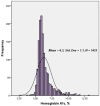Glycosylated hemoglobin A1c as a marker predicting the severity of coronary artery disease and early outcome in patients with stable angina
- PMID: 24884794
- PMCID: PMC4070346
- DOI: 10.1186/1476-511X-13-89
Glycosylated hemoglobin A1c as a marker predicting the severity of coronary artery disease and early outcome in patients with stable angina
Abstract
Background: Glycosylated hemoglobin A1C (HbA1c) has been widely recognized as a marker for predicting the severity of diabetes mellitus (DM) and several cardiovascular diseases. However, whether HbA1c could predict the severity and clinical outcomes in patients with stable coronary artery disease (CAD) remains largely unknown. We determine relationship of HbA1c with severity and outcome in patients with stable CAD.
Methods: We enrolled 1433 patients with stable angina who underwent coronary angiography and were followed up for an average 12 months. The patients were classified into three groups by tertiles of baseline HbA1c level (low group <5.7%, n = 483; intermediate group 5.7 - 6.3%, n = 512; high group >6.3%, n = 438). The relationships between the plasma HbA1c and severity of CAD and early clinical outcomes were evaluated.
Results: High HbA1c was associated with three-vessel disease. Area under the receivers operating characteristic curve (AUC = 0.67, 95% CI: 0.63-0.71, P < 0.001) and multivariate logistic regression analysis suggested that HbA1C was an independent predictor of severity of CAD (OR = 1.60, 95% CI: 1.29-1.99, P < 0.001) even after adjusting for gender, age, risk factor of CAD, lipid profile and fasting blood glucose. During follow-up, 133 patients underwent pre-specified outcomes. After adjusting for multiple variables in the Cox regression model, HbA1C remained to be an independent predictor of poor prognosis (HR = 1.28, 95% CI: 1.12-1.45, P < 0.001).
Conclusions: We concluded that high level of baseline HbA1c appeared to be an independent predictor for the severity of CAD and poor outcome in patients with stable CAD.
Figures





Similar articles
-
Impact of admission triglyceride for early outcome in diabetic patients with stable coronary artery disease.Lipids Health Dis. 2014 Apr 27;13:73. doi: 10.1186/1476-511X-13-73. Lipids Health Dis. 2014. PMID: 24766776 Free PMC article.
-
Association of fibrinogen with severity of stable coronary artery disease in patients with type 2 diabetic mellitus.Dis Markers. 2014;2014:485687. doi: 10.1155/2014/485687. Epub 2014 Apr 6. Dis Markers. 2014. PMID: 24803720 Free PMC article.
-
Hemoglobin A1C in non-diabetic patients: an independent predictor of coronary artery disease and its severity.Diabetes Res Clin Pract. 2013 Dec;102(3):225-32. doi: 10.1016/j.diabres.2013.10.011. Epub 2013 Oct 9. Diabetes Res Clin Pract. 2013. PMID: 24176244
-
Admission glucose, fasting glucose, HbA1c levels and the SYNTAX score in non-diabetic patients undergoing coronary angiography.Clin Res Cardiol. 2014 Mar;103(3):223-7. doi: 10.1007/s00392-013-0641-7. Epub 2013 Nov 24. Clin Res Cardiol. 2014. PMID: 24271460
-
Glycated hemoglobin level is significantly associated with the severity of coronary artery disease in non-diabetic adults.Lipids Health Dis. 2014 Dec 4;13:181. doi: 10.1186/1476-511X-13-181. Lipids Health Dis. 2014. PMID: 25477191 Free PMC article.
Cited by
-
Glycosylated hemoglobin, but not advanced glycation end products, predicts severity of coronary artery disease in patients with or without diabetes.Metabol Open. 2020 Aug 16;7:100050. doi: 10.1016/j.metop.2020.100050. eCollection 2020 Sep. Metabol Open. 2020. PMID: 32924001 Free PMC article.
-
Significance of HbA1c Test in Diagnosis and Prognosis of Diabetic Patients.Biomark Insights. 2016 Jul 3;11:95-104. doi: 10.4137/BMI.S38440. eCollection 2016. Biomark Insights. 2016. PMID: 27398023 Free PMC article. Review.
-
The Role of Glycated Hemoglobin A1c in Determining the Severity of Coronary Artery Disease in Diabetic and Non-Diabetic Subjects in Karachi.Cureus. 2019 Jun 24;11(6):e4982. doi: 10.7759/cureus.4982. Cureus. 2019. PMID: 31467816 Free PMC article.
-
The Association between Hemoglobin A1c and the Severity of Coronary Artery Disease in Non-diabetic Patients with Acute Coronary Syndrome.Cureus. 2020 Jan 12;12(1):e6631. doi: 10.7759/cureus.6631. Cureus. 2020. PMID: 32064206 Free PMC article.
-
General glycosylated hemoglobin goals potentially increase myocardial infarction severity in diabetes patients with comorbidities: Insights from a nationwide multicenter study.J Diabetes Investig. 2020 Nov;11(6):1498-1506. doi: 10.1111/jdi.13287. Epub 2020 Jun 13. J Diabetes Investig. 2020. PMID: 32383543 Free PMC article.
References
-
- Lorenzo C, Wagenknecht LE, Hanley AJ, Rewers MJ, Karter AJ, Haffner SM. A1C Between 5.7 and 6.4% as a Marker for Identifying Pre-Diabetes, Insulin Sensitivity and Secretion, and Cardiovascular Risk Factors The Insulin Resistance Atherosclerosis Study (IRAS) Diabetes Care. 2010;33:2104–2109. doi: 10.2337/dc10-0679. - DOI - PMC - PubMed
Publication types
MeSH terms
Substances
LinkOut - more resources
Full Text Sources
Other Literature Sources
Medical
Miscellaneous

